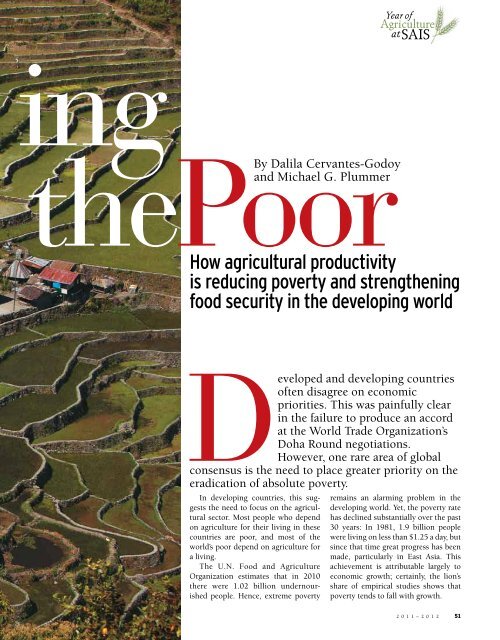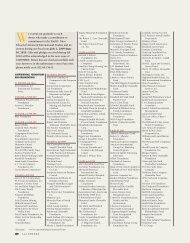Download Current Issue - SAIS
Download Current Issue - SAIS
Download Current Issue - SAIS
You also want an ePaper? Increase the reach of your titles
YUMPU automatically turns print PDFs into web optimized ePapers that Google loves.
ing<br />
thePoor<br />
By Dalila Cervantes-Godoy<br />
and Michael G. Plummer<br />
Year of<br />
Agriculture<br />
at<strong>SAIS</strong><br />
How agricultural productivity<br />
is reducing poverty and strengthening<br />
food security in the developing world<br />
Developed and developing countries<br />
often disagree on economic<br />
priorities. This was painfully clear<br />
in the failure to produce an accord<br />
at the World Trade Organization’s<br />
Doha Round negotiations.<br />
However, one rare area of global<br />
consensus is the need to place greater priority on the<br />
eradication of absolute poverty.<br />
In developing countries, this suggests<br />
the need to focus on the agricultural<br />
sector. Most people who depend<br />
on agriculture for their living in these<br />
countries are poor, and most of the<br />
world’s poor depend on agriculture for<br />
a living.<br />
The U.N. Food and Agriculture<br />
Organization estimates that in 2010<br />
there were 1.02 billion undernourished<br />
people. Hence, extreme poverty<br />
remains an alarming problem in the<br />
developing world. Yet, the poverty rate<br />
has declined substantially over the past<br />
30 years: In 1981, 1.9 billion people<br />
were living on less than $1.25 a day, but<br />
since that time great progress has been<br />
made, particularly in East Asia. This<br />
achievement is attributable largely to<br />
economic growth; certainly, the lion’s<br />
share of empirical studies shows that<br />
poverty tends to fall with growth.<br />
2011–2012 51



